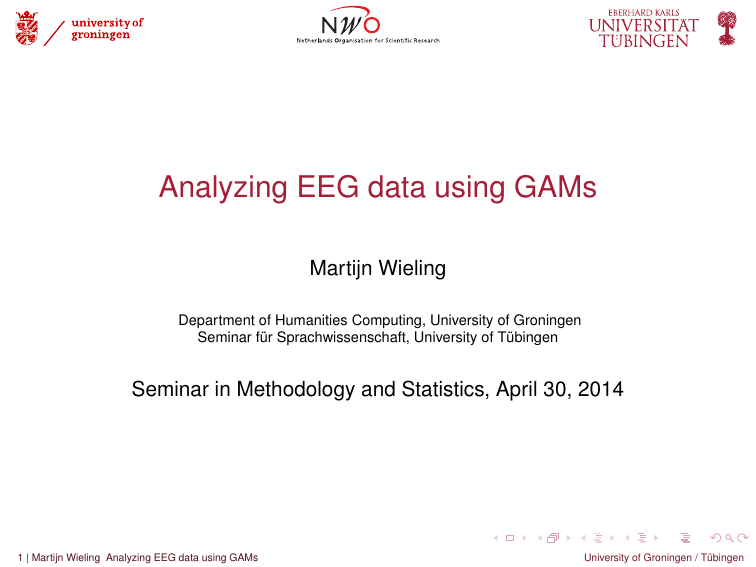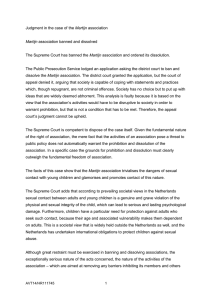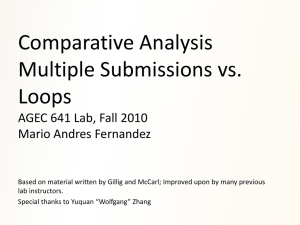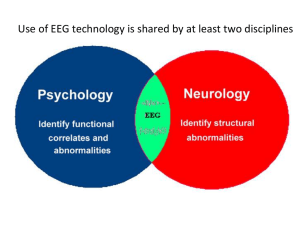Analyzing EEG data using GAMs
advertisement

Analyzing EEG data using GAMs
Martijn Wieling
Department of Humanities Computing, University of Groningen
Seminar für Sprachwissenschaft, University of Tübingen
Seminar in Methodology and Statistics, April 30, 2014
1 | Martijn Wieling Analyzing EEG data using GAMs
University of Groningen / Tübingen
Overview
I
Introduction
I
I
I
I
Some words about linear regression
Generalized additive mixed-effects regression modeling
ERPs to study gender violations
Research question
I
Design
I
Methods: R code
I
Results
I
Discussion
2 | Martijn Wieling Analyzing EEG data using GAMs
University of Groningen / Tübingen
A linear regression model
I
linear model: linear relationship between predictors and dependent
variable: y = a1 x1 + ... + an xn
I
I
Non-linearities via explicit parametrization: y = a1 x12 + a2 x1 + ...
Interactions not very flexible
0.4
0
linear predictor
0.2
x2
0.0
0.2
.2
−0
−0
0.1
5
.15
−0.1
0.1
−0.05
0.05
0
0.05
−0.2
icto
red
p
ar
line
x2
5
−0.0
0.1
.1
−0
r
−0.4
0.1
.15
−0
5
0.2
.2
−0
x1
−0.4
−0.2
0.0
0.2
0.4
x1
3 | Martijn Wieling Analyzing EEG data using GAMs
University of Groningen / Tübingen
A generalized additive model (1)
I
generalized additive model (GAM): relationship between individual
predictors and (possibly transformed) dependent variable is estimated by
a non-linear smooth function: g(y ) = s(x1 ) + s(x2 , x3 ) + a4 x4 + ...
I
multiple predictors can be combined in a (hyper)surface smooth
0
44.0
0.1
Contour plot
−0.4
−0.1
.1
−0
−0.5
.3
−0
−0.2
−0.
1
−0.4
0
Latitude
43.5
−0.4
0.1
−0.3
−0.2
0
.3
−0
43.0
0.1
−0.5
−0.1
42.5
−0.2
10.0
10.5
11.0
11.5
12.0
Longitude
4 | Martijn Wieling Analyzing EEG data using GAMs
University of Groningen / Tübingen
A generalized additive model (2)
I
Advantage of GAM over manual specification of non-linearities: the
optimal shape of the non-linearity is determined automatically
I
I
appropriate degree of smoothness is automatically determined on the basis
of cross validation to prevent overfitting
Choosing a smoothing basis
I
Single predictor or isotropic predictors: thin plate regression spline
I
Combining non-isotropic predictors: tensor product spline
I
I
Generalized Additive Mixed Modeling:
I
I
I
Efficient approximation of the optimal (thin plate) spline
Random effects can be treated as smooths as well (Wood, 2008)
R: gam and bam (package mgcv)
For more (mathematical) details, see Wood (2006)
5 | Martijn Wieling Analyzing EEG data using GAMs
University of Groningen / Tübingen
ERPs to study grammatical gender violations
I
A P600 (a positivity ‘around’ 600 ms. after stimulus onset) is sensitive to
grammatical violations
I
An N400 (a negativity ‘around’ 400 ms. after stimulus onset) is modulated
by semantic context and lexical properties of a word
I
The P600/N400 are found by comparing the incorrect sentences to the
correct sentences
I
Native speakers appear to show a P600 for gender violations
I
But analyzed by averaging over items and over subjects!
I
Here we are interested in how non-native speakers respond to gender
violations (joint work with Nienke Meulman)
I
Gender is very hard to learn for L2 learners
I
Even though behaviorally L2 learners might show correct responses, the
brain may reveal differences in processing gender
6 | Martijn Wieling Analyzing EEG data using GAMs
University of Groningen / Tübingen
Research question
I
Is the P600 for gender violations dependent on age of arrival for the L2
learners of German?
7 | Martijn Wieling Analyzing EEG data using GAMs
University of Groningen / Tübingen
ERP data
I
Today: analysis of single region of interest (ROI 8)
I
GAMs allow for spatial distribution analyses
8 | Martijn Wieling Analyzing EEG data using GAMs
University of Groningen / Tübingen
Design
I
67 L2 speakers of German (Slavic L1)
I
I
Auditory presentation of correct sentences or sentences with a gender
violation (incorrect determiner; no determiners in L1)
48 items in each condition: 96 trials per participant (minus artifacts)
I
Example:
Nach der Schlägerei ist das/*der Auge des Angestellten von der
Krankenschwester versorgt worden.
After the fight theneut /*themasc eye of the worker was treated by the nurse.
9 | Martijn Wieling Analyzing EEG data using GAMs
University of Groningen / Tübingen
Data overview
> load('dat.rda')
# data needs to be sorted to test for autocorrelation problems
> dat = dat[order(dat$Subject, dat$TrialNr, dat$Time, decreasing=F),]
> head(dat)
44947
28121
40909
1294
9446
81324
44947
28121
40909
1294
9446
81324
mV Time Subject
8.94400 505
GL102
15.56267 515
GL102
21.30807 525
GL102
13.31573 535
GL102
19.10700 545
GL102
17.95607 555
GL102
Structure Correctness
DN
incor
DN
incor
DN
incor
DN
incor
DN
incor
DN
incor
> dim(dat)
[1] 442160
Group
GenEarly
GenEarly
GenEarly
GenEarly
GenEarly
GenEarly
L1 AoArr
PL
8
PL
8
PL
8
PL
8
PL
8
PL
8
Word TrialNr
Roi
Wald
2 post.mid
Wald
2 post.mid
Wald
2 post.mid
Wald
2 post.mid
Wald
2 post.mid
Wald
2 post.mid
LoR Age Edu SeqStart
24 32
3
TRUE
24 32
3
FALSE
24 32
3
FALSE
24 32
3
FALSE
24 32
3
FALSE
24 32
3
FALSE
15
10 | Martijn Wieling Analyzing EEG data using GAMs
University of Groningen / Tübingen
A lot of individual variation
(the signal has been downsampled to 100 Hz)
GL103
GL104
mV
0
−10
mV
10
20
10
10
5
0
5
mV
0
−5
−5
−30
GL102
0
500
1000
−500
0
500
1000
−500
500
Time (ms.)
Time (ms.)
GL105
GL106
GL107
−5
1000
0
−2
2
−500
0
500
1000
Time (ms.)
11 | Martijn Wieling Analyzing EEG data using GAMs
10
8
10
6
5
5
4
mV
mV
0
−5
0
mV
0
Time (ms.)
−10
−500
−500
0
500
Time (ms.)
1000
−500
0
500
1000
Time (ms.)
University of Groningen / Tübingen
General patterns exist
(note the arbitrary age split, however)
−500
0
500
1000
Time (ms.)
12 | Martijn Wieling Analyzing EEG data using GAMs
−2
−1
mV
4
3
2
1
0
−1
4
3
2
mV
1
0
−1
0
1
4
3
2
mV
Age of arrival between 17 and 37
−2
Age of arrival between 7 and 16
−2
Native controls
−500
0
500
Time (ms.)
1000
−500
0
500
1000
Time (ms.)
University of Groningen / Tübingen
A first model: a general effect of time
(to prevent too wiggly curves split up data in 2 partially overlapping time spans: here 500-1300 ms)
> m0 = bam(mV ~ s(Time), data=dat, gc.level=2, method='ML')
> summary(m0)
Family: gaussian
Link function: identity
Formula:
mV ~ s(Time)
Parametric coefficients:
Estimate Std. Error t value Pr(>|t|)
(Intercept) -0.06120
0.02774 -2.206
0.0274 *
Approximate significance of smooth terms:
edf Ref.df
F p-value
s(Time) 3.917
4.84 25.95 <2e-16 ***
R-sq.(adj) = 0.000284
Deviance explained = 0.0293%
ML score = 1.9162e+06 Scale est. = 340.13
n = 442160
13 | Martijn Wieling Analyzing EEG data using GAMs
University of Groningen / Tübingen
Visualizing the time pattern
> par(mfrow=c(1,2)) # 2 plots in one window
> plot(m0, rug=F, shade=T, ylim=c(0.5,-1), seWithMean=T,
ylab='mV', main='m0: partial effect')
> abline(h = 0) # horizontal line at y = 0
> ic = m0$coef["(Intercept)"] # intercept (-0.06) from model
> plot(m0, rug=F, shade=T, ylim=c(0.5-ic,-1-ic), seWithMean=T, shift = ic,
ylab='mV', main='m0: shifted by intercept')
> abline(h = 0)
−0.5
mV
0.0
0.5
0.5
0.0
mV
−0.5
−1.0
m0: shifted by intercept
−1.0
m0: partial effect
600
800
1000
Time
14 | Martijn Wieling Analyzing EEG data using GAMs
1200
600
800
1000
1200
Time
University of Groningen / Tübingen
Check for additional wigglyness
(if p-value is low and edf close to k’; default for s: 10dim - 1, default for te: 5dim - 1)
> gam.check(m0)
Method: ML
Optimizer: outer newton
full convergence after 2 iterations.
Gradient range [-0.6306798,0.1689593]
(score 1916153 & scale 340.1335).
Hessian positive definite, eigenvalue range [1.948326,221080.6].
Basis dimension (k) checking results. Low p-value (k-index<1) may
indicate that k is too low, especially if edf is close to k'.
k'
edf k-index p-value
s(Time) 9.000 3.917
0.993
0.27
15 | Martijn Wieling Analyzing EEG data using GAMs
University of Groningen / Tübingen
Increasing the wigglyness of a smooth with k
(double k if higher k is needed, but do not set it too high, i.e. max
1
2
× unique time points)
> m0b = bam(mV ~ s(Time, k=20), data=dat, gc.level=2, method='ML')
> summary(m0b)
Family: gaussian
Link function: identity
Formula:
mV ~ s(Time, k = 20)
Parametric coefficients:
Estimate Std. Error t value Pr(>|t|)
(Intercept) -0.06119
0.02774 -2.205
0.0274 *
Approximate significance of smooth terms:
edf Ref.df
F p-value
s(Time) 4.038
5.04 24.94 <2e-16 *** # was 3.917
R-sq.(adj) = 0.000284
Deviance explained = 0.0293%
ML score = 1.9162e+06 Scale est. = 340.13
n = 442160
16 | Martijn Wieling Analyzing EEG data using GAMs
University of Groningen / Tübingen
Assessing correct versus incorrect
(smooths are centered, so the factorial predictor also needs to be included in the fixed effects)
> m1 = bam(mV ~ s(Time,by=Correctness) + Correctness, data=dat,
gc.level=2, method='ML')
> summary(m1)
Family: gaussian
Link function: identity
Formula:
mV ~ s(Time, by = Correctness) + Correctness
Parametric coefficients:
Estimate Std. Error t value Pr(>|t|)
(Intercept)
-0.50692
0.03920 -12.93
<2e-16 ***
Correctnessincor 0.89174
0.05546
16.08
<2e-16 ***
Approximate significance of smooth terms:
edf Ref.df
F p-value
s(Time):Correctnesscor
1.043 1.085 13.35 0.000194 ***
s(Time):Correctnessincor 4.370 5.375 46.70 < 2e-16 ***
R-sq.(adj) = 0.00117
Deviance explained = 0.118%
ML score = 1.916e+06 Scale est. = 339.83
n = 442160
17 | Martijn Wieling Analyzing EEG data using GAMs
University of Groningen / Tübingen
Visualizing both patterns: partial effects
> par(mfrow=c(1,2))
> plot(m1, select=1,
seWithMean=T,
> plot(m1, select=2,
seWithMean=T,
shade=T, rug=F, ylim=c(2,-2), shade.col='green',
main='m1: correct'); abline(h = 0)
shade=T, rug=F, ylim=c(2,-2), shade.col='red',
main='m1: incorrect'); abline(h = 0)
−1
0
2
1
s(Time,4.37):Correctnessincor
−1
0
1
2
s(Time,1.04):Correctnesscor
−2
m1: incorrect
−2
m1: correct
600
800
1000
Time
18 | Martijn Wieling Analyzing EEG data using GAMs
1200
600
800
1000
1200
Time
University of Groningen / Tübingen
Visualizing both patterns: complete model context
>
>
#
#
#
source('plotting.R') # custom plotting functions
plotSmooths(m1, "Time", "Correctness", colors=c('green','red'))
Note that if there are additional variables in the model
plotSmooths sets these to the specified value (via the 'cond' parameter)
or to their mean / most frequent value.
mV
1
0.5
0
−0.5
−1
−1.5
Model: m1
Correctness
cor
incor
600
800
1000
1200
Time
19 | Martijn Wieling Analyzing EEG data using GAMs
University of Groningen / Tübingen
Visualizing the differences
> plotDiff(m1, "Time", "Correctness")
1.5
1
0.5
mV
0
−0.5
−1
Difference between cor and incor
600
800
1000
1200
Time
20 | Martijn Wieling Analyzing EEG data using GAMs
University of Groningen / Tübingen
Model comparison
I
For comparing differences in the fixed effects (constant random effects)
of two models use method="ML"
I
For comparing differences in the random effects (constant fixed effects)
of two models use method="fREML" (bam only) or method="REML"
I
There are three possibilities for comparing GAM models:
I
I
I
I
Look at the p-values of the model summary (recommended)
Compare AIC values (at least reduction of 2): AIC(m0) - AIC(m1)
Compare (fRE)ML values: compareML(m0,m1)
The table below shows when which method can be applied:
(N.B. rho is used to correct for autocorrelation in the residuals and explained later)
gam
bam
Gaussian without rho
(RE)ML / AIC / summary
(fRE)ML / AIC / summary
21 | Martijn Wieling Analyzing EEG data using GAMs
Gaussian with rho
(fRE)ML / summary
Non-Gaussian
(RE)ML / AIC / summary
AIC / summary
University of Groningen / Tübingen
Model comparison and model fitting
> source('compareML.R') # custom function for comparing ML/(f)REML scores
> compareML(m0,m1)
m0: mV ~ s(Time)
m1: mV ~ s(Time, by = Correctness) + Correctness
Chi-square test of ML scores
----Model
Score Edf
Chisq
Df
1
m0 1916153
3
2
m1 1915957
6 196.169 3.000
p.value Sig.
< 2e-16
*** # m1 is clearly much better
AIC difference: 389.52, model m1 has lower AIC.
I
Different fitting methods for GAMs (method="..."):
I
I
I
I
ML: conservative, but biased variance components (oversmoothing)
fREML/REML: better smooths, but less conservative p-values
GCV.Cp: good for prediction, but not robust to autocorrelation problems
I generally use method="ML" for my final model (conservative)
22 | Martijn Wieling Analyzing EEG data using GAMs
University of Groningen / Tübingen
Explicit test for significant difference between levels
(smooths for a binary by-variable are not centered, so no change to the fixed effects)
> dat$IsIncorrect = (dat$Correctness == 'incor')*1
> m1b = bam(mV ~ s(Time) + s(Time,by=IsIncorrect), data=dat, gc.level=2,
method='ML')
> summary(m1b)
Family: gaussian
Link function: identity
Formula:
mV ~ s(Time) + s(Time, by = IsIncorrect)
Parametric coefficients:
Estimate Std. Error t value Pr(>|t|)
(Intercept) -0.5069
0.0392 -12.93
<2e-16 ***
Approximate significance of smooth terms:
edf Ref.df
F p-value
s(Time)
1.022 1.042 13.11 0.000257 ***
s(Time):IsIncorrect 5.239 6.221 81.03 < 2e-16 ***
R-sq.(adj) = 0.00117
Deviance explained = 0.118%
ML score = 1.916e+06 Scale est. = 339.83
n = 442160
23 | Martijn Wieling Analyzing EEG data using GAMs
University of Groningen / Tübingen
Visualizing correct and incorrect difference
(identical shape as the difference curve of model m1)
> plot(m1b, shade=T, rug=F, ylim=c(1.8,-1.2), select=2,
main='Difference m1b', ylab='mV', seWithMean=T)
> abline(h = 0)
1.5
1.0
0.5
mV
0.0
−0.5
−1.0
Difference m1b
600
800
1000
1200
Time
24 | Martijn Wieling Analyzing EEG data using GAMs
University of Groningen / Tübingen
Changing the reference level
(note that the model becomes more complex in this case)
> dat$IsCorrect = (dat$Correctness == 'cor')*1
> m1c = bam(mV ~ s(Time) + s(Time,by=IsCorrect), data=dat, gc.level=2,
method='ML')
> summary(m1c)
...
Parametric coefficients:
Estimate Std. Error t value Pr(>|t|)
(Intercept) 0.38389
0.03922
9.788
<2e-16 ***
Approximate significance of smooth terms:
edf Ref.df
F p-value
s(Time)
4.698 5.731 43.10 <2e-16 ***
s(Time):IsCorrect 4.778 5.656 69.32 <2e-16 ***
R-sq.(adj) = 0.00118
Deviance explained = 0.12%
ML score = 1.916e+06 Scale est. = 339.83
n = 4421600
25 | Martijn Wieling Analyzing EEG data using GAMs
University of Groningen / Tübingen
Visualization with different reference level
> par(mfrow=c(1,2))
> plotSmooths(m1c, "Time", "IsCorrect", colors=c('red','green'))
> plot(m1c, shade=T, rug=F, select=2, main='Difference',
ylab='mV', ylim=c(1.2,-1.8), seWithMean=T)
> abline(h = 0)
Difference
−0.5
mV
0.5
0.5
0.0
0
mV
−0.5
−1.0
−1
−1.5
−1.5
Model: m1c
1.0
1
IsCorrect
0
1
600
800
1000
Time
26 | Martijn Wieling Analyzing EEG data using GAMs
1200
600
800
1000
1200
Time
University of Groningen / Tübingen
Comparing models with a different reference level
I
m1c is more complex than m1b and also results in a worse fit
I
Thus: the reference level matters with binary contrasts!
> compareML(m1b,m1c)
m1b: mV ~ s(Time) + s(Time, by = IsIncorrect)
m1c: mV ~ s(Time) + s(Time, by = IsCorrect)
Chi-square test of ML scores
----Model
Score Edf Chisq
Df
1
m1c 1915964
6
2
m1b 1915959
6 5.102 0.000
p.value Sig.
< 2e-16
***
AIC difference: -0.64, model m1b has lower AIC.
27 | Martijn Wieling Analyzing EEG data using GAMs
University of Groningen / Tübingen
Separating intercept and smooth difference
(the binary by-variable combines the intercept and smooth difference)
> dat$CorrectnessO = as.ordered(dat$Correctness)
> contrasts(dat$CorrectnessO) = 'contr.treatment' # contrast treatment
> m1d = bam(mV ~ s(Time) + s(Time,by=CorrectnessO) + CorrectnessO, data=dat,
gc.level=2, method='ML')
> summary(m1d)
...
Formula:
mV ~ s(Time) + s(Time, by = CorrectnessO) + CorrectnessO
Parametric coefficients:
Estimate Std. Error t value Pr(>|t|)
(Intercept)
-0.50671
0.03920 -12.93
<2e-16 ***
CorrectnessOincor 0.89148
0.05546
16.07
<2e-16 *** # similar to m1
Approximate significance of smooth terms:
edf Ref.df
F p-value
s(Time)
1.510 1.851 6.994 0.00147 **
s(Time):CorrectnessOincor 4.258 5.241 36.513 < 2e-16 *** # edf: 1 below m1b
R-sq.(adj) = 0.00117
Deviance explained = 0.119%
ML score = 1.916e+06 Scale est. = 339.83
n = 442160
28 | Martijn Wieling Analyzing EEG data using GAMs
University of Groningen / Tübingen
Visualizing correct and incorrect difference
> plot(m1b, shade=T, rug=F, ylim=c(1.8,-2.0), select=2,
main='Difference m1b', ylab='mV', seWithMean=T)
> abline(h = 0)
> plot(m1d, shade=T, rug=F, ylim=c(1.8,-2.0), select=2,
main='Difference m1d (without intercept)', ylab='mV', seWithMean=T)
> abline(h = 0)
−1
mV
0
1
0
1
mV
−1
−2
Difference m1d (without intercept)
−2
Difference m1b
600
800
1000
Time
29 | Martijn Wieling Analyzing EEG data using GAMs
1200
600
800
1000
1200
Time
University of Groningen / Tübingen
Taking into account individual variation
I
I
The effect of time is non-linear and is variable per subject
We need a random intercept/slope which is non-linear
I
(instead of random intercepts and slopes of time per subject)
> summary(m2 <- bam(mV ~ s(Time,by=Correctness) + Correctness +
s(Time,Subject,bs='fs',m=1), data=dat,
gc.level=2, method='ML'))
...
Parametric coefficients:
Estimate Std. Error t value Pr(>|t|)
(Intercept)
-0.55611
0.29553 -1.882
0.0599 .
Correctnessincor 0.88609
0.05493 16.132
<2e-16 ***
Approximate significance of smooth terms:
edf Ref.df
F p-value
s(Time):Correctnesscor
1.295
1.458 2.901 0.0704 .
s(Time):Correctnessincor
4.220
5.145 26.494 <2e-16 ***
s(Time,Subject)
229.770 602.000 14.490 <2e-16 ***
R-sq.(adj) = 0.0205
ML score = 1.9119e+06
30 | Martijn Wieling Analyzing EEG data using GAMs
Deviance explained =
Scale est. = 333.26
2.1%
n = 442160
University of Groningen / Tübingen
Lots of individual variation
5
0
−5
s(Time,Subject,229.77)
10
> plot(m2, select=3)
600
800
1000
1200
Time
31 | Martijn Wieling Analyzing EEG data using GAMs
University of Groningen / Tübingen
Smooths become more uncertain
> par(mfrow=c(1,2))
> plotSmooths(m2, "Time", "Correctness", colors=c('green','red'),
dropRanef="Subject")
> plotDiff(m2, "Time", "Correctness")
Difference between cor and incor
0
mV
0.5
0
1
1
0.5
mV
−0.5
−1
−0.5
−1.5
−1
Model: m2
1.5
1.5
Correctness
cor
incor
600
800
1000
Time
32 | Martijn Wieling Analyzing EEG data using GAMs
1200
600
800
1000
1200
Time
University of Groningen / Tübingen
Autocorrelation in the data is a huge problem!
(residuals should be independent, otherwise the standard errors and p-values are wrong)
# It is essential that the data used in m2 is sorted per individual EEG
# signal sequence (per subject, per trial, per ROI, etc.). The best rho
# value can be found by trying different values and comparing models. The
# autocorrelation at lag 1 for the same model w/o rho seems to work well,
# however. A good practice is to use the lowest value possible which has
# a good acf plot and is not significantly worse than the best rho model.
> m2acf = acf(resid(m2)) # show autocorrelation
> rho = as.vector(m2acf[1]$acf)
> rho
[1] 0.9123131 # correlation of residuals at time t with those at time t-1
0.6
0.4
0.0
0.2
ACF
0.8
1.0
Series resid(m2)
0
10
20
30
40
50
Lag
33 | Martijn Wieling Analyzing EEG data using GAMs
University of Groningen / Tübingen
Correcting for autocorrelation
(rho can only be used with bam, not with gam)
> m3 = bam(mV ~ s(Time,by=Correctness) + Correctness +
s(Time,Subject,bs='fs',m=1), data=dat,
gc.level=2, method='ML', rho=rho, AR.start=SeqStart)
> summary(m3)
...
Parametric coefficients:
Estimate Std. Error t value Pr(>|t|)
(Intercept)
-0.5601
0.3169 -1.768
0.0771 .
Correctnessincor
0.9218
0.2177
4.235 2.29e-05 ***
Approximate significance of smooth terms:
edf Ref.df
F p-value
s(Time):Correctnesscor
1.080
1.156 0.230
0.667
s(Time):Correctnessincor 3.088
4.016 6.773 1.87e-05 ***
s(Time,Subject)
57.862 602.000 0.736 < 2e-16 ***
R-sq.(adj) = 0.0186
ML score = 1.4923e+06
34 | Martijn Wieling Analyzing EEG data using GAMs
Deviance explained = 1.87%
Scale est. = 291.56
n = 442160
University of Groningen / Tübingen
Autocorrelation has been removed
> acf.new(m2, m3, "Time") # custom plotting function
ACF
0.4
0.0
0.0
0.2
0.2
0.4
ACF
0.6
0.6
0.8
0.8
1.0
New acf with rho: 0.91
1.0
Original acf
0
10
20
30
Lag
35 | Martijn Wieling Analyzing EEG data using GAMs
40
50
0
10
20
30
40
50
Lag
University of Groningen / Tübingen
Clear model improvement
> compareML(m2,m3)
m2: mV ~ s(Time,
s(Time,
m3: mV ~ s(Time,
s(Time,
by = Correctness) +
Subject, bs = "fs",
by = Correctness) +
Subject, bs = "fs",
Correctness +
m = 1)
Correctness +
m = 1)
Chi-square test of ML scores
----Model
Score Edf
Chisq
Df
1
m2 1911925
8
2
m3 1492310
8 419615.303 0.000
p.value Sig.
< 2e-16
***
Warning message:
In compareML(m2, m3) :
AIC is not reliable, because an AR1 model is included
(rho1 = 0.000000, rho2 = 0.912313).
> AIC(m2) - AIC(m3) # AIC indeed does not work when using rho
[1] -701.3066
36 | Martijn Wieling Analyzing EEG data using GAMs
University of Groningen / Tübingen
Here: random wiggly curves ≈ random intercepts
(computation could be made faster by using s(Subject,bs="re") instead)
6
4
2
0
−2
−4
s(Time,Subject,57.86)
8
> plot(m3, select=3)
600
800
1000
1200
Time
37 | Martijn Wieling Analyzing EEG data using GAMs
University of Groningen / Tübingen
Resulting smooths: much larger confidence intervals
> par(mfrow=c(1,2))
> plotSmooths(m3, "Time", "Correctness", colors=c('green','red'),
dropRanef="Subject")
> plotDiff(m3, "Time", "Correctness")
Difference between cor and incor
0
mV
1
1.5
1
Correctness
cor
incor
600
2
1.5
0.5
0
0.5
mV
−0.5
−1
−0.5
−1
−1.5
Model: m3
800
1000
Time
38 | Martijn Wieling Analyzing EEG data using GAMs
1200
600
800
1000
1200
Time
University of Groningen / Tübingen
Our research question: the effect of age of arrival
# in this lecture, rho is always set to the acf at lag 1 for the
# same model without rho
> m4 = bam(mV ~ te(Time,AoArr,by=Correctness) + Correctness +
s(Time,Subject,bs='fs',m=1), data=dat,
gc.level=2, method='ML', rho=rho, AR.start=SeqStart)
> summary(m4)
...
Parametric coefficients:
Estimate Std. Error t value Pr(>|t|)
(Intercept)
-0.5476
0.3173 -1.726
0.0844 .
Correctnessincor
0.9038
0.2177
4.151 3.31e-05 ***
Approximate significance of smooth terms:
edf Ref.df
F p-value
te(Time,AoArr):Correctnesscor
3.423
3.809 1.585
0.177
te(Time,AoArr):Correctnessincor 5.975
7.145 4.679 2.62e-05 ***
s(Time,Subject)
56.540 601.000 0.738 < 2e-16 ***
R-sq.(adj) =
0.02
Deviance explained = 2.02%
ML score = 1.4923e+06 Scale est. = 291.11
n = 442160
39 | Martijn Wieling Analyzing EEG data using GAMs
University of Groningen / Tübingen
Visualization of the 2-dimensional smooths
#
#
#
#
Custom plotting functions are used to plot the partial effects
(i.e. the general pattern) and difference surfaces.
N.B. a surface including all effects (at pre-specified levels) can be
visualized using vis.gam(...) - see additional slides at the end.
> par(mfrow=c(1,3))
> pvis.gam(m4, plot.type='contour', view=c('Time','AoArr'), select=1,
color='topo', main='m4: cor (not significant)')
> pvis.gam(m4, plot.type='contour', view=c('Time','AoArr'), select=2,
color='topo', main='m4: incor')
> plotDiff2D(m4, "Time", "AoArr", "Correctness", plotCI=T)
Difference between cor and incor
−2
35
2
35
m4: incor
35
m4: cor (not significant)
−4
−1.5
600
800
1000
1200
Time
40 | Martijn Wieling Analyzing EEG data using GAMs
30
15
15
1.5
600
800
1000
Time
1
10
−1
0.5
10
−0.5
10
15
0
0
0.5
−1
0
1
0
1.5
1
2
1
2.5
2
25
AoArr
25
AoArr
20
25
AoArr
20
0.5
−3−5
0
−1
−2
−0.5
20
30
30
−1
1
−1
−2
−3
−0.5
1.5
1200
600
800
2
3.5
3
3
4.5
4
1000
1200
Time
University of Groningen / Tübingen
Interpreting 2-dimensional smooths
Difference between cor and incor
30
30
−2
800
1000
1200
600
800
25
1000
AoArr
3
20
2
0
1
15
AoArr
20
3
15
15
2
1
10
20
1
−1
0
2
10
25
−1
0
10
3
1200
600
800
1000
1200
Difference between cor and incor (AoArr: 10)
Difference between cor and incor (AoArr: 20)
Difference between cor and incor (AoArr: 30)
600
800
1000
1200
Time
41 | Martijn Wieling Analyzing EEG data using GAMs
0
mV
2
4
4
2
mV
0
4
2
−2
Time
−2
Time
−2
Time
0
AoArr
25
−1
600
−3
−2
30
−2
mV
Difference between cor and incor
−3
35
35
−3
35
Difference between cor and incor
600
800
1000
Time
1200
600
800
1000
1200
Time
University of Groningen / Tübingen
Significance testing using a binary variable
(an ordered factor may be used to separate the intercept difference from the difference surface)
> m4b = bam(mV ~ te(Time,AoArr) + te(Time,AoArr,by=IsIncorrect) +
s(Time,Subject,bs='fs',m=1), data=dat,
gc.level=2, method='ML', rho=rho, AR.start=SeqStart)
...
Parametric coefficients:
Estimate Std. Error t value Pr(>|t|)
(Intercept) -0.5224
0.3216 -1.624
0.104
Approximate significance of smooth terms:
edf Ref.df
F p-value
te(Time,AoArr)
2.109
2.831 1.032
0.37
te(Time,AoArr):IsIncorrect 6.771
7.918 8.308 3.55e-11 ***
s(Time,Subject)
57.598 602.000 0.749 < 2e-16 ***
R-sq.(adj) =
0.02
Deviance explained = 2.01%
ML score = 1.4923e+06 Scale est. = 291.11
n = 442160
42 | Martijn Wieling Analyzing EEG data using GAMs
University of Groningen / Tübingen
Visualizing the difference surface
(note that m4b is a different model than m4, so the difference surfaces do not need to be identical)
> pvis.gam(m4b, plot.type='contour', view=c('Time','AoArr'),
contour.col='black', select=2, color='topo',
main='m4b: difference surface')
m4b: difference surface
35
−2.5
−1.5
30
−2
20
−1
1.5
0.5
10
0
15
AoArr
25
−0.5
2
1
2.5
600
3
3.5
800
1000
1200
Time
43 | Martijn Wieling Analyzing EEG data using GAMs
University of Groningen / Tübingen
Assessing if k needs to be increased
(note that k = 10 has the same effect as k = c(10,10))
> m4c = bam(mV ~ te(Time,AoArr,by=Correctness,k=c(10,10)) + Correctness +
s(Time,Subject,bs='fs',m=1), data=dat,
gc.level=2, method='ML', rho=rho, AR.start=SeqStart)
> compareML(m4,m4c) # the additional complexity is not needed
...
Chi-square test of ML scores
----Model
Score Edf Chisq
Df p.value Sig.
1
m4c 1492296 14
2
m4 1492295 14 0.856 0.000 < 2e-16 ***
...
> summary(m4c) # max edf: 99 (10^2 - 1)
...
edf Ref.df
F p-value
te(Time,AoArr):Correctnesscor
4.450
5.678 1.194
0.305
te(Time,AoArr):Correctnessincor 6.576
8.394 3.948 8.58e-05 ***
...
44 | Martijn Wieling Analyzing EEG data using GAMs
University of Groningen / Tübingen
Adding random wiggly curves per word
> require(parallel)
> cl <- makeCluster(4) # use 4 processors for computation
> summary(m5 <- bam(mV ~ te(Time,AoArr,by=Correctness) +
Correctness + s(Time,Subject,bs='fs',m=1) +
s(Time,Word,bs='fs',m=1), data=dat, gc.level=2,
method='ML', rho=rho, AR.start=SeqStart, cluster=cl))
Parametric coefficients:
Estimate Std. Error t value Pr(>|t|)
(Intercept)
-0.5760
0.3581 -1.609
0.108
Correctnessincor
0.8934
0.2185
4.088 4.35e-05 ***
Approximate significance of smooth terms:
edf Ref.df
te(Time,AoArr):Correctnesscor
3.935
4.719
te(Time,AoArr):Correctnessincor 6.012
7.206
s(Time,Subject)
56.955 601.000
s(Time,Word)
65.427 855.000
R-sq.(adj) = 0.0295
ML score = 1.4922e+06
45 | Martijn Wieling Analyzing EEG data using GAMs
F p-value
1.377
0.23
4.668 2.58e-05 ***
0.741 < 2e-16 ***
0.261 < 2e-16 ***
Deviance explained = 2.98%
Scale est. = 290.96
n = 442160
University of Groningen / Tübingen
Model comp. not essential for random wiggly curves
I
Even though model comparison may suggest that random wiggly curves
do not improve the model, it is useful to keep them in (if they are
significant in the summary) to control for item and subject effects
> compareML(m4r, m5r) # here, however the model does improve
# m4r and m5r are the same as m4 and m5, but with method='REML'
# (required when comparing random effects)
m4r: mV ~ te(Time, AoArr, by = Correctness) + Correctness +
s(Time, Subject, bs = "fs", m = 1)
m5r: mV ~ te(Time, AoArr, by = Correctness) + Correctness +
s(Time,Subject, bs = "fs", m = 1) +
s(Time, Word, bs = "fs", m = 1)
Chi-square test of REML scores
----Model
Score Edf Chisq
Df p.value Sig.
1
m4r 1492290
14
2
m5r 1492235
16 55.014 2.000 < 2e-16 ***
46 | Martijn Wieling Analyzing EEG data using GAMs
University of Groningen / Tübingen
Decomposition: the pure effect of age of arrival
(note that the 2-dimensional interactions are not significant)
> summary(m5b <- bam(mV ~ s(Time,by=Correctness) + s(AoArr,by=Correctness) +
ti(Time,AoArr,by=Correctness) + Correctness +
s(Time,Subject,bs='fs',m=1) +
s(Time,Word,bs='fs',m=1), data=dat, gc.level=2,
method='ML', rho=rho, AR.start=SeqStart, cluster=cl))
...
(Intercept)
Correctnessincor
Estimate Std. Error t value Pr(>|t|)
-0.5794
0.3571 -1.623
0.105
0.8970
0.2180
4.115 3.87e-05 ***
Approximate significance of smooth terms:
edf Ref.df
s(Time):Correctnesscor
1.192
1.361
s(Time):Correctnessincor
3.088
4.015
s(AoArr):Correctnesscor
2.111
2.592
s(AoArr):Correctnessincor
1.011
1.017
ti(Time,AoArr):Correctnesscor
1.893
2.633
ti(Time,AoArr):Correctnessincor 2.198
3.133
s(Time,Subject)
56.515 601.000
s(Time,Word)
65.570 855.000
47 | Martijn Wieling Analyzing EEG data using GAMs
F p-value
0.380
0.6025
6.769 1.88e-05 ***
1.420
0.2327
4.976
0.0252 *
1.060
0.3516
0.438
0.7347
0.722 < 2e-16 ***
0.261 < 2e-16 ***
University of Groningen / Tübingen
A simpler model
> m5c = bam(mV ~ s(Time,by=Correctness) + s(AoArr,by=Correctness) +
Correctness + s(Time,Subject,bs='fs',m=1) +
s(Time,Word,bs='fs',m=1), data=dat, gc.level=2,
method='ML', rho=rho, AR.start=SeqStart, cluster=cl)
> summary(m5c)
(Intercept)
Correctnessincor
Estimate Std. Error t value Pr(>|t|)
-0.5829
0.3562 -1.636
0.102
0.9024
0.2175
4.149 3.34e-05 ***
Approximate significance of smooth terms:
edf Ref.df
F p-value
s(Time):Correctnesscor
1.027
1.054 0.344
0.5693
s(Time):Correctnessincor
3.091
4.019 6.792 1.79e-05 ***
s(AoArr):Correctnesscor
3.404
4.151 1.159
0.3255
s(AoArr):Correctnessincor 1.003
1.004 4.859
0.0274 *
s(Time,Subject)
56.249 601.000 0.709 < 2e-16 ***
s(Time,Word)
65.453 855.000 0.261 < 2e-16 ***
R-sq.(adj) = 0.0296
ML score = 1.4922e+06
48 | Martijn Wieling Analyzing EEG data using GAMs
Deviance explained = 2.99%
Scale est. = 290.96
n = 442160
University of Groningen / Tübingen
Model comparison: the simpler model is sufficient
> compareML(m5,m5c)
m5: mV ~ te(Time, AoArr, by = Correctness) + Correctness + s(Time,
Subject, bs = "fs", m = 1) + s(Time, Word, bs = "fs", m = 1)
m5c: mV ~ s(Time, by = Correctness) + s(AoArr, by = Correctness) +
Correctness + s(Time, Subject, bs = "fs", m = 1) +
s(Time, Word, bs = "fs", m = 1)
Chi-square test of ML scores
----Model
Score Edf Chisq
Df p.value Sig.
1
m5c 1492237 14
2
m5 1492234 16 2.564 2.000
0.077
Warning messages:
1: In compareML(m5, m5c) :
AIC is not reliable, because an AR1 model is included
2: In compareML(m5, m5c) : Only small difference in ML...
49 | Martijn Wieling Analyzing EEG data using GAMs
University of Groningen / Tübingen
Testing for significant smooth differences
(a binary variable may only occur once in a model, so ordered factors are essential here)
> m6 <- bam(mV ~ s(Time) + s(Time,by=CorrectnessO) + s(AoArr) +
s(AoArr,by=CorrectnessO) + CorrectnessO + ... )
> summary(m6)
...
Parametric coefficients:
Estimate Std. Error t value Pr(>|t|)
(Intercept)
-0.8574
0.3532 -2.428
0.0152 *
CorrectnessOincor
0.8900
0.2182
4.079 4.52e-05 ***
Approximate significance of smooth terms:
edf Ref.df
F
s(Time)
1.324
1.568 0.596
s(Time):CorrectnessOincor
2.945
3.823 5.231
s(AoArr)
1.049
1.057 0.201
s(AoArr):CorrectnessOincor 1.011
1.021 33.584
s(Time,Subject)
56.591 600.000 0.708
s(Time,Word)
65.434 855.000 0.258
...
I
p-value
0.496843
0.000465
0.667579
5.72e-09
< 2e-16
< 2e-16
***
***
***
***
Thus: the data of Nienke clearly shows a highly significant decreasing
effect of age of arrival on the P600
50 | Martijn Wieling Analyzing EEG data using GAMs
University of Groningen / Tübingen
Difference curves
> par(mfrow=c(1,2))
> plot(m6, shade=T, rug=F, select=2, ylim=c(1.2,-2.5),
main='Effect of Incorrectness', ylab='mV', seWithMean=T)
> abline(h = 0)
> plot(m6, shade=T, rug=F, select=4, ylim=c(3,-4.5),
main='Effect of Age of Arrival', ylab='mV', seWithMean=T)
> abline(h = 0)
Effect of Age of Arrival
mV
1
2
0
0
mV
−1
−2
−2
−4
Effect of Incorrectness
600
800
1000
Time
51 | Martijn Wieling Analyzing EEG data using GAMs
1200
10
15
20
25
30
35
AoArr
University of Groningen / Tübingen
Finally: model criticism
>
>
>
>
library(car)
par(mfrow=c(1,2))
qqplot.rho(m6) # custom qqplot of residuals taking rho into account
hist.rho(m6) # custom histogram of residuals taking rho into account
I
Common pattern for EEG data, hard to correct (work in progress...)
I
For now, use a more conservative p-value such as 0.001
52 | Martijn Wieling Analyzing EEG data using GAMs
University of Groningen / Tübingen
Discussion
I
I
Still much to do: e.g., testing the significance of other possibly important
variables (proficiency, age, etc.)
But don’t make it too complex!
I
I
There is much variation present in EEG data and adding very complex
surfaces will almost certainly improve your model significantly
K.I.S.S., otherwise you won’t be able to interpret the results
53 | Martijn Wieling Analyzing EEG data using GAMs
University of Groningen / Tübingen
Conclusion
I
GAMs are very useful to analyze EEG and other time-series data
I
I
The method is very suitable to detect non-linear patterns, while taking into
account individual variation and correcting for autocorrelation
If you are interested in GAMs and mixed-effects regression and would
like to learn more about this in a hands-on setting, you are welcome to
participate in my 5-day crash course (June 23 - June 27):
http://goo.gl/tZRTr3
54 | Martijn Wieling Analyzing EEG data using GAMs
University of Groningen / Tübingen
Thank you for your attention!
55 | Martijn Wieling Analyzing EEG data using GAMs
University of Groningen / Tübingen
Visualization: vis.gam vs. pvis.gam (1)
> m4b = bam(mV ~ te(Time,AoArr) + te(Time,AoArr,by=IsIncorrect) +
s(Time,Subject,bs='fs',m=1), data=dat,
gc.level=2, method='ML', rho=rho, AR.start=SeqStart)
> par(mfrow=c(2,2))
> vis.gam(m4b, plot.type='contour', view=c('Time','AoArr'),
contour.col='black', cond=list(IsIncorrect=0,Subject='GL107'),
color='topo', main='vis.gam - m4b: cor (Subject: GL107)')
> vis.gam(m4b, plot.type='contour', view=c('Time','AoArr'),
contour.col='black', cond=list(IsIncorrect=1,Subject='GL107'),
color='topo', main='vis.gam - m4b: incor (Subject: GL107)')
> pvis.gam(m4b, plot.type='contour', view=c('Time','AoArr'),
contour.col='black', select=1, color='topo',
main='pvis.gam - m4b: cor (independent of subject)')
> pvis.gam(m4b, plot.type='contour', view=c('Time','AoArr'),
contour.col='black', select=2, color='topo',
main='pvis.gam - m4b: difference surface')
56 | Martijn Wieling Analyzing EEG data using GAMs
University of Groningen / Tübingen
Visualization: vis.gam vs. pvis.gam (2)
(vis.gam shows the resulting surface of the conditions, pvis.gam shows the smooths in your model)
35
−1
−1.5
−0.5
30
30
0.5
25
25
1.35
1.1
AoArr
1.3
1.25
20
AoArr
vis.gam − m4b: incor (Subject: GL107)
1.4
1.5
0
20
35
vis.gam − m4b: cor (Subject: GL107)
2.5
1.0
15
15
1.2
5
10
10
3.5
2
1.15
1.1
600
1
800
1000
4
3
1
1200
4.5
600
800
1000
1200
35
pvis.gam − m4b: difference surface
0.25
0.2
30
pvis.gam − m4b: cor (independent of subject)
35
Time
30
Time
−2.5
−2
−1.5
−1
−0.5
25
AoArr
0
0.5
20
−0.05
AoArr
20
25
0.15
0.1
0
1.5
15
15
0.05
5
10
−0.1
10
−0.1
600
2.5
1
5
−0.0
2
800
1000
Time
57 | Martijn Wieling Analyzing EEG data using GAMs
1200
600
3.5
3
800
1000
1200
Time
University of Groningen / Tübingen
Differences between ML, REML and GCV
ML is conservative, but the variance component (i.e. smooth) is biased
(oversmoothed)
(f)REML is less conservative, but robust to moderate autocorrelation,
and the smooth is not biased
GCV.Cp is better for prediction, but not robust to autocorrelation
Strongest approach is to compare results across different methods (i.e.
using AIC)
I
I
I
method="fREML"
1
Correctness
cor
incor
600
−1
0.5
0.5
0
mV
0
mV
−0.5
−0.5
−1
−1
−0.5
mV
0
0.5
1
method="GCV.Cp"
−1.5
−1.5
method="ML"
Correctness
1
I
cor
incor
800
1000
1200
Time
58 | Martijn Wieling Analyzing EEG data using GAMs
600
800
1000
Time
1200
Correctness
cor
incor
600
800
1000
1200
Time
University of Groningen / Tübingen





